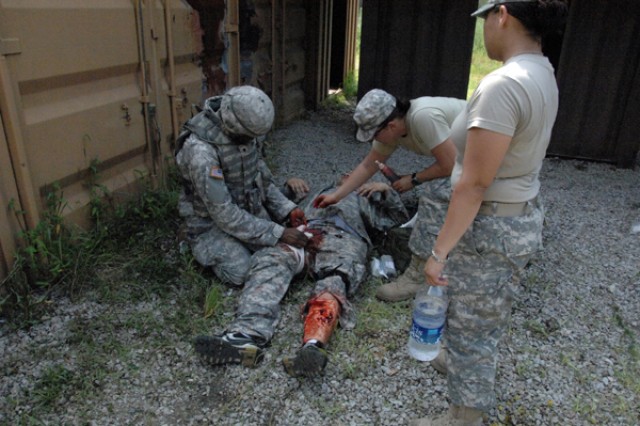
CASEY GARRISON South Korea - The 210th Fires Brigade spent time at the range on USAG-Casey July 31 learning and practicing combat life saving skills. This hands-on training was met with simulated live fire action complete with yellow smoke and the usual hustle of live combat, and real-time coaching from combat life saving experts barking orders and prodding Soldiers to do the right things in order and move quickly with their battle buddies acting as wounded Soldiers.
"The point of this exercise in combat life saving is to give the Soldiers a chance to get hands-on experience in simulated combat to prepare them for real life scenarios," said Spc. Patrick Holms, chief combat life saving instructor. "I personally organized this training today."
Capt. Darwin Maull made sure the training included real simulated live fire and smoke.
"My battery provides the resources as the ammunition and pyrotechnics used to make this training as close to actual combat as possible," Maull said. "Most of the medics belong to me."
When patients are fully treated as far as they can be in a combat area, they are taken to an evacuation site to be moved to a combat hospital in the area, Holms said.
The training did not just happen on the range; there were four days of day-long classroom activities including learning how to stick someone with a needle for an intravenous infusion.
"More than 40 hours of classroom and 10 to 15 hours of hands-on training is spent for the entire course, Holms said. "We have spent more than 10 hours per day for this course."
The battlefield simulation was made as real as possible to train Soldiers for combat situations, which may arise when deployed to combat zones, Holms went on to say.
"We will not certify just anyone," Holms said. "This program of training took two months of planning and preparation."
After completing the training Soldiers must pass examinations to receive certification.
"There are three critical things students must successfully achieve," Holms said. "The IV stick, pass a 40 question written test, and qualify with their instructor's approval for the hands-on training."
After passing the Combat Life Saving course, Soldiers are ready to help wounded Soldiers in actual combat, Holms explained.
"Combat Life Savers are the bridge between self-aid on the battlefield and the combat medic," said Maj. Luciel Pryor-Cordes, 210 Fires Brigade. "They will be the first ones on site to help wounded Soldiers in an actual battle."
"This training will not just help people in the battlefield," Maull said. "Anyone who has taken this training can use these techniques to help someone who may be injured in a vehicle accident. These Soldiers will be able to apply life saving skills until emergency services can arrive."

Social Sharing